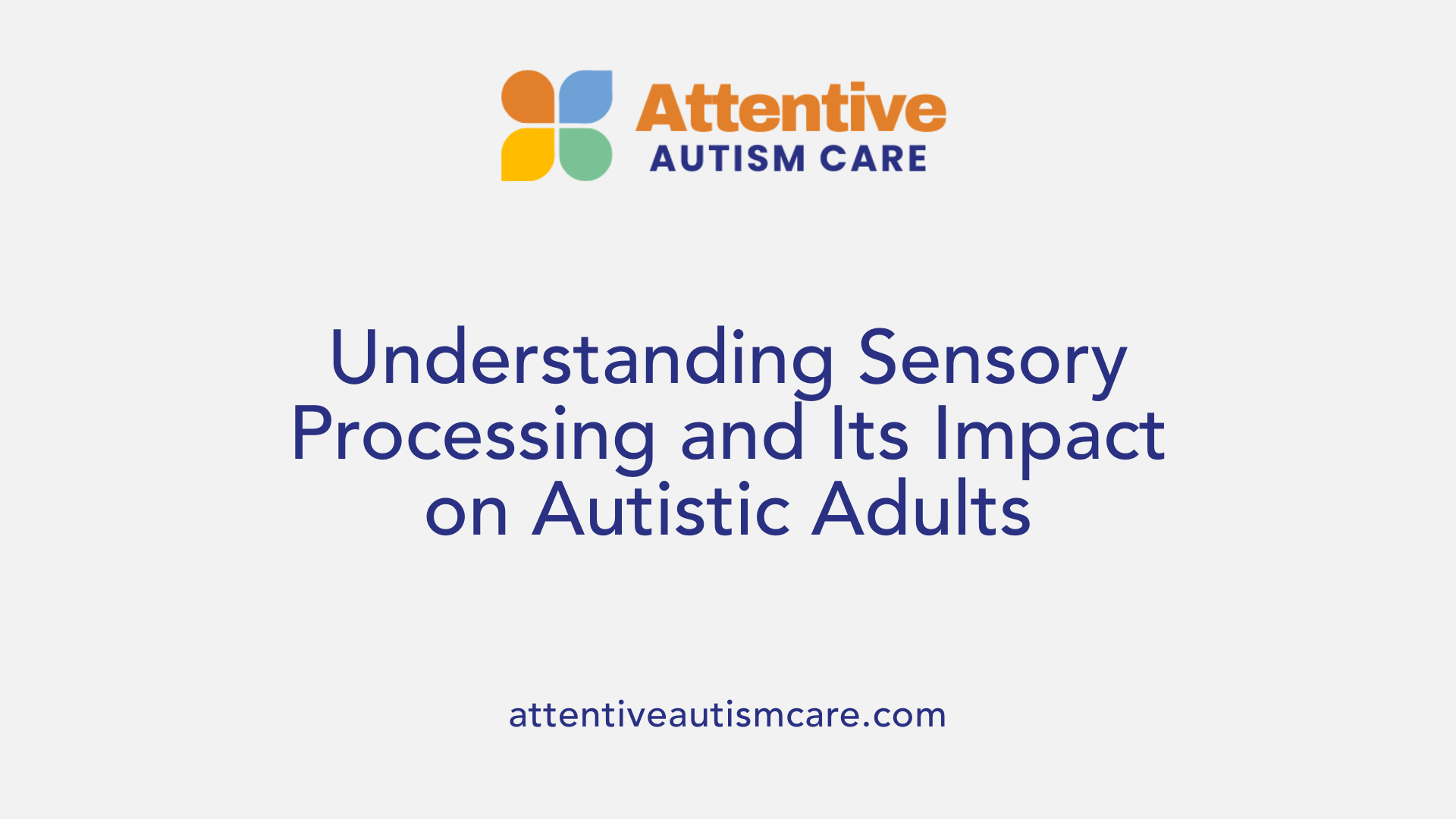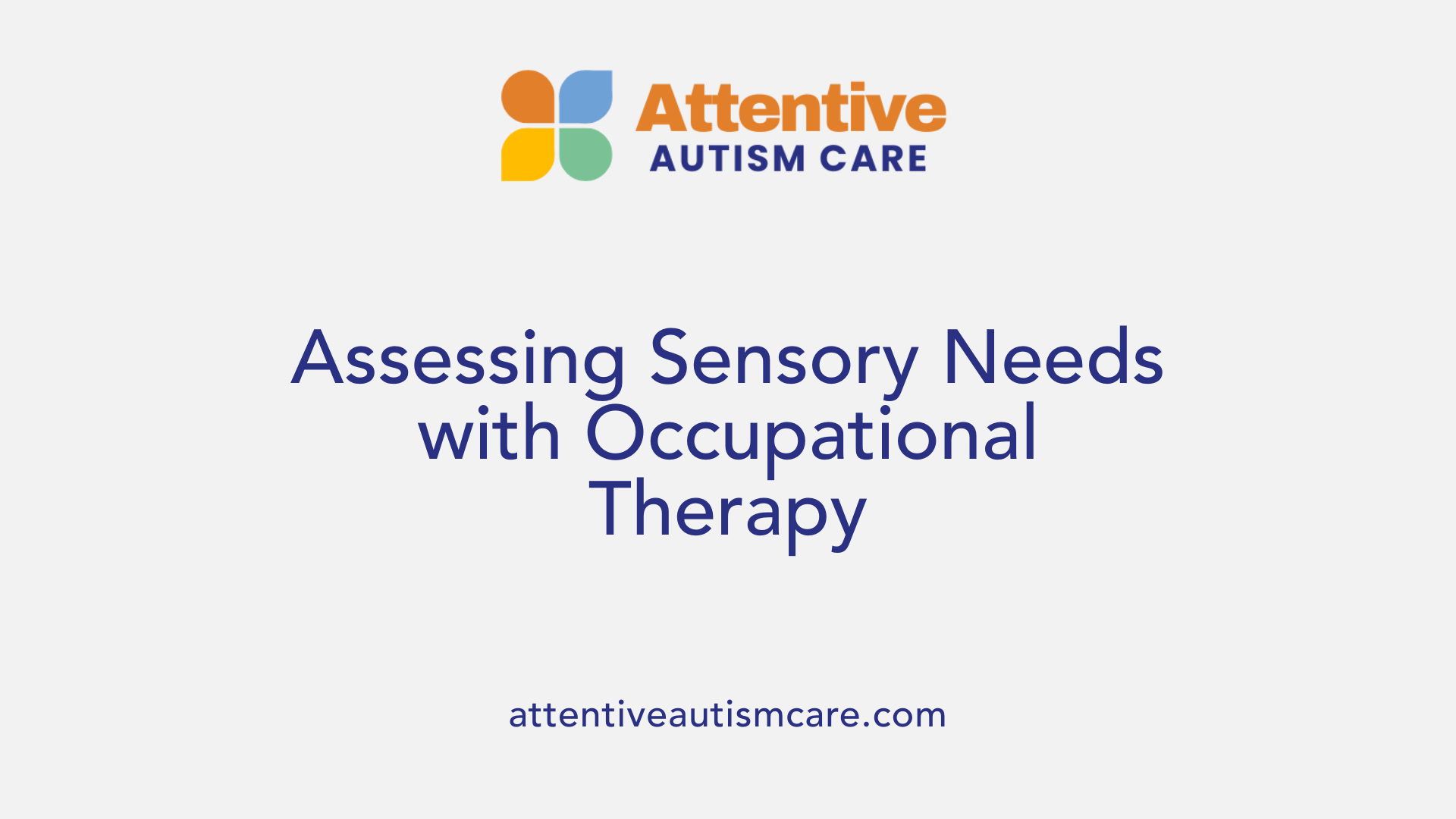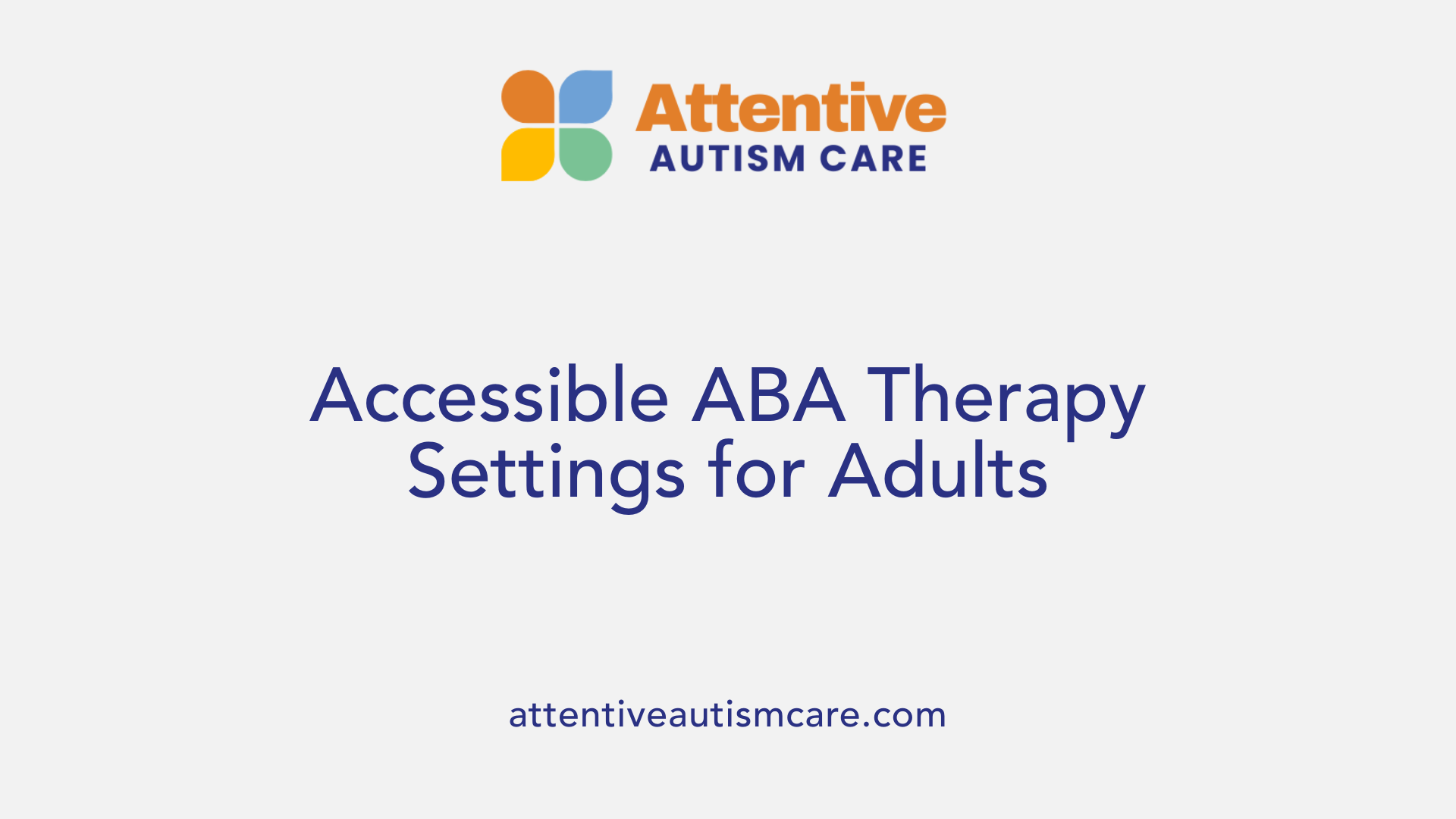Supporting Autistic Adults in Managing High Sensory Needs
Understanding and Empowering Adults with High Sensory Needs on the Autism Spectrum

Introduction to Sensory Needs in Autism
Sensory processing differences are a fundamental aspect of how many autistic adults experience the world. These differences can manifest as hyper-sensitivity or hypo-sensitivity to a variety of sensory inputs, affecting daily living, mental health, and social interactions. Recognizing and supporting high sensory needs in autistic adults is crucial to fostering autonomy, well-being, and quality of life. This article explores sensory processing, its impact, and therapeutic approaches including Applied Behavior Analysis (ABA) within a framework that honors neurodiversity and individual preferences.
What is Sensory Processing and How Does It Affect Autistic Adults?

What is sensory processing?
Sensory processing refers to the brain's method of interpreting information received from our senses. For autistic individuals, this process often operates differently compared to non-autistic people, leading to variations in how sensory information is perceived.
Brain-based differences vs physical sensory deficits
Importantly, these sensory differences are rooted in how the brain functions and connects rather than any medical or physical impairments in the sensory organs themselves. This means autistic adults do not have sensory organ damage but instead experience unique brain activity patterns affecting perception.
Types of sensory sensitivities
Autistic adults may experience hypersensitivity, where senses react more intensely than usual, or hyposensitivity, where sensory input is less noticeable. Often, individuals experience a combination of both across different senses and at various times.
Common sensory triggers
Certain environmental factors frequently act as sensory triggers, such as bright or flickering lights, loud or sudden noises, unexpected touches, strong smells, and specific textures. These stimuli can either overwhelm or go unnoticed, depending on the individual's sensitivity profile.
Variation in sensory experiences over time
Sensory sensitivities in autistic adults are not fixed; they can fluctuate over time and vary between different sensory modalities. This variability means that an individual’s sensory experience may change with context, health, or stress levels, influencing daily activities and comfort.
Understanding these aspects of sensory processing helps in creating supportive environments and interventions tailored to the individual's sensory profile, promoting better daily experiences and well-being.
Recognizing Hyper-Sensitivity and Hypo-Sensitivity in Adults with Autism
How do sensory sensitivities manifest in autistic individuals?
Autistic adults often experience sensory sensitivities that can be broadly categorized into hyper-sensitivity and hypo-sensitivity, which may vary across different senses and fluctuate over time. Hyper-sensitivity involves an increased reaction to stimuli such as bright lights, loud noises, unexpected touch, certain smells, and specific textures. For example, an adult might find the glare from fluorescent lighting painful or feel overwhelmed by the chatter and noise of a busy environment. Conversely, hypo-sensitivity refers to a decreased awareness or responsiveness; some individuals may not notice certain stimuli or might seek intense sensory experiences to satisfy this need.
Examples of hyper- and hypo-sensitivities
- Hyper-sensitivities: Discomfort or distress from bright lights, loud sounds, rough or sticky textures, pungent odors, or unexpected touch.
- Hypo-sensitivities: Reduced reaction to pain or temperature, high tolerance for noise, or seeking strong tactile sensations such as deep pressure or vigorous movement.
How sensory needs fluctuate
Sensory sensitivities are not fixed; they can change depending on factors like stress levels, environment, or health. An adult may tolerate certain sensory input on a good day but become overwhelmed under stress or fatigue. This variability means that sensory needs should be assessed regularly and addressed dynamically.
Impact on behavior and comfort
When sensory input becomes overwhelming, known as sensory overload, autistic adults may exhibit distress behaviors such as withdrawal, agitation, or increased anxiety. Similarly, hypo-sensitivities might lead to seeking behaviors that others could misunderstand. These sensory processing differences significantly affect comfort, social interactions, and overall quality of life.
Understanding and recognizing these sensory patterns are crucial for developing supportive approaches that respect individual sensory profiles and improve daily functioning and well-being.
Sensory Overload: Causes, Consequences, and Signs to Watch For
What is Sensory Overload?
Sensory overload occurs when an individual receives more sensory input than their brain can effectively process. For autistic individuals, this means their senses may be either hyper-sensitive or hypo-sensitive, and sometimes both, which varies across different senses and over time. When overloaded, the brain struggles to interpret incoming stimuli, leading to feelings of distress.
What Are Common Triggers of Sensory Overload?
Several sensory inputs typically lead to overload, especially bright lights, loud noises, unexpected touches, specific smells, and particular textures. These triggers can overwhelm an autistic person's sensory system because of differences in brain activity and connectivity rather than any physical issues with the senses themselves.
How Does Sensory Overload Affect Behavior and Emotions?
When experiencing sensory overload, individuals might show behavioral responses such as withdrawal, agitation, or distress behaviors. Emotional responses can include anxiety, frustration, or feeling overwhelmed. Sensory overload can interfere significantly with daily life, impacting eating habits, sleep quality, social interactions, and mental health.
Why is Early Recognition Important?
Recognizing sensory overload early allows for timely interventions that can reduce its impact. Occupational therapists often assess sensory processing differences to tailor strategies like sensory integration therapy, sensory diets, or sensory circuits. Early identification helps individuals and caregivers manage triggers proactively, promoting better quality of life and minimizing distress.
| Aspect | Details | Impact |
|---|---|---|
| Definition | Brain's difficulty processing excess sensory input | Leads to overwhelming sensations and distress |
| Common Triggers | Bright lights, loud noises, unexpected touch, certain smells, specific textures | Can provoke sensory overload episodes |
| Behavioral Responses | Withdrawal, agitation, distress behaviors | Disrupts daily routines, social interactions |
| Emotional Responses | Anxiety, frustration, feeling overwhelmed | Affects mental health and well-being |
| Early Recognition | Assessment by occupational therapists, tailored interventions | Enables proactive management and improves quality of life |
Impact of Sensory Processing Differences on Daily Life and Mental Health
How do sensory processing differences affect eating and sleeping?
Sensory sensitivities can deeply influence basic activities like eating and sleeping. For example, certain textures or smells of food may be overwhelming or unappealing due to hyper-sensitivity, leading to limited diets or feeding difficulties. Similarly, sensory disruptions such as loud noises or bright lights can interfere with sleep quality, causing difficulties falling or staying asleep.
What challenges arise in social interactions due to sensory differences?
Social settings often involve unpredictable sensory inputs like touching, noises, or crowded spaces. Sensory processing differences may cause some autistic individuals to feel overwhelmed or avoid social engagements, making communication and forming relationships more challenging. Sensory sensitivities can also affect the ability to focus or respond appropriately during interactions.
How are sensory processing differences related to mental health issues?
The ongoing management of sensory challenges may contribute to stress, anxiety, and emotional distress. Sensory overload—when the brain cannot handle excessive sensory input—often results in distress behaviors and heightened anxiety. Over time, this can negatively impact overall mental health and well-being.
What is sensory overload and how does it cause distress?
Sensory overload occurs when sensory stimuli become too intense or too numerous for the brain to process effectively. This can lead to feelings of agitation, discomfort, and even meltdown behaviors as a response to the overwhelming inputs. Such experiences impair day-to-day functioning and increase emotional strain.
Understanding these impacts emphasizes the importance of recognizing and addressing sensory processing differences to improve quality of life and mental health for autistic individuals.
Assessment of Sensory Needs: Role of Occupational Therapy

How Are Sensory Processing Differences Assessed?
Occupational therapists (OTs) play a crucial role in assessing sensory processing in autistic individuals. They use various methods to evaluate how a person responds to sensory inputs such as light, sound, touch, smell, and texture. These assessments often include standardized questionnaires, direct observation of behaviors in different settings, and sensory processing scales designed to identify hyper- or hypo-sensitivity across senses.
Why Is Individualized Sensory Evaluation Important?
Each autistic person experiences sensory processing uniquely, with some showing increased sensitivity to certain stimuli while others may have decreased sensitivity or a combination that fluctuates over time. Because sensory responses can significantly affect daily functioning—such as eating, sleeping, and social interactions—an individualized evaluation ensures that interventions address specific sensory challenges and preferences rather than using a one-size-fits-all approach.
How Do Assessments Inform Tailored Interventions?
The detailed information gathered through sensory assessments guides occupational therapists in creating personalized intervention plans. These plans may incorporate sensory integration therapy, sensory diets (planned activities providing specific sensory input), or sensory circuits that help regulate sensory input effectively. Tailored interventions aim to reduce sensory overload and improve overall comfort, participation in activities, and quality of life.
By focusing on the unique sensory profile of each individual, occupational therapists can optimize support strategies, making daily environments more manageable and enhancing engagement in both social and learning contexts.
Therapeutic Interventions Addressing Sensory Differences

What Are Sensory Integration Therapy, Sensory Diets, and Sensory Circuits?
Therapeutic approaches to sensory processing differences in autistic individuals often include sensory integration therapy, sensory diets, and sensory circuits. These are designed to help individuals better manage sensory input and reduce distress caused by sensory overload.
Sensory Integration Therapy focuses on improving the brain's ability to process and respond to sensory information. Through guided activities, it aims to enhance sensory modulation and coordination.
Sensory Diets are personalized plans that incorporate specific sensory activities throughout the day. These activities help maintain optimal arousal and regulate sensory sensitivity, providing a balance between overstimulation and understimulation.
Sensory Circuits are structured sequences of physical exercises that prepare individuals for learning or daily activities by regulating sensory systems, improving attention and emotional regulation.
How Effective Are These Interventions?
While these therapies are commonly used by occupational therapists, research findings on their effectiveness vary. Some individuals experience meaningful improvements in managing sensory sensitivities, leading to better engagement in daily life tasks such as eating, sleeping, and social interaction.
However, scientific studies have shown mixed results, with some reviews calling for more rigorous research to validate benefits and standardize intervention protocols. Effectiveness may depend heavily on individual differences, the specific sensory profiles of autistic persons, and consistency of therapy.
Tailoring Sensory Interventions
Occupational therapists usually conduct assessments to understand unique sensory processing patterns and design interventions accordingly. Customization ensures that sensory activities meet the needs of each autistic person, addressing hyper- or hypo-sensitivities across different senses and minimizing distress caused by sensory overload.
By integrating sensory integration therapy, sensory diets, and sensory circuits—while adapting approaches as individual needs evolve—therapists aim to support autistic individuals in regulating sensory input and improving their overall well-being.
An Overview of Applied Behavior Analysis (ABA) Therapy
What is applied behavior analysis (ABA) therapy?
Applied behavior analysis (ABA) therapy is a scientifically-supported behavioral treatment designed to improve specific skills and reduce challenging behaviors in individuals with autism spectrum disorder (ASD) and other developmental conditions. ABA is grounded in the principles of learning and behavior, focusing on how environment influences actions and how modifying antecedents and consequences can lead to positive behavior change.
Principles of learning and behavior in ABA
ABA relies heavily on understanding the Antecedent-Behavior-Consequence (ABC) model. This means examining what happens before a behavior (antecedent), the behavior itself, and what follows it (consequence). Positive reinforcement—praising or providing rewards such as toys or access to play—is a key strategy to encourage repetition of desired behaviors. This approach helps increase helpful actions while decreasing behaviors that may impede learning or are harmful.
Structured interventions: DTT, PRT, and ESDM
ABA incorporates several structured techniques tailored to the individual's needs. Discrete Trial Training (DTT) is a highly structured method using clear, step-by-step instructions and rewards to teach skills while minimizing undesired responses. Pivotal Response Treatment (PRT) focuses on improving pivotal areas such as communication initiation in naturalistic settings, promoting broader developmental gains.
The Early Start Denver Model (ESDM) targets young children aged 12 to 48 months by blending ABA principles with play and social engagement to enhance language, learning, and social skills. These interventions emphasize enjoyment and positive social interactions, adapting to each child's unique profile.
Customizable programs and settings
ABA therapy programs are individualized based on comprehensive assessments by board-certified behavior analysts (BCBAs). These professionals develop personalized goals encompassing communication, social skills, self-care, play, motor skills, and academics. Data collection and regular progress monitoring guide adjustments to treatment.
ABA is flexible and delivered across various settings, including homes, schools, and community environments. This adaptability helps generalize skills across contexts, increasing real-life applicability.
Providers and professional oversight
Certified professionals such as BCBAs design and supervise ABA interventions. Therapy implementation may include registered behavior technicians (RBTs) who carry out daily sessions under BCBA guidance. Families and caregivers are often trained to support therapy goals, facilitating consistent reinforcement beyond therapy hours.
Research endorses ABA therapy as an evidence-based best practice for ASD, showing significant improvements in intellectual ability, language, social competence, and daily functioning. It is widely supported by organizations including the American Psychological Association and the US Surgeon General, reflecting its status as a cornerstone intervention in autism treatment.
How ABA Therapy Benefits Autistic Individuals with Sensory Needs
How does ABA therapy benefit individuals with autism?
ABA therapy supports autistic individuals by teaching crucial skills that improve communication, social interaction, and daily functioning. These improvements foster greater independence, allowing individuals to navigate daily life with increased confidence and success.
This evidence-based approach utilizes positive reinforcement strategies, such as praise or rewards, to encourage the repetition of helpful behaviors while systematically reducing problematic ones. ABA programs are personalized to the unique needs of each individual, ensuring that interventions are relevant and effective.
Tailored interventions in ABA can be delivered across multiple environments — including home, school, and community settings — which helps skills generalize to real-life situations and reduces sensory challenges by providing controlled, predictable learning contexts.
Early and intensive ABA intervention has shown especially encouraging outcomes. When started before the age of four, it often leads to substantial developmental progress in communication, social skills, and cognitive abilities. This early support is critical in helping children better manage sensory sensitivities and behavioral responses.
ABA therapy also emphasizes understanding factors influencing behavior through the ABC model (Antecedent-Behavior-Consequence). This approach helps identify sensory triggers and develop strategies to modify behaviors that may arise from sensory overload or hypo- or hyper-sensitivities.
Together, these elements of ABA therapy contribute to enhanced quality of life by addressing sensory needs through structured, positive, and individualized learning experiences.
Who Provides ABA Therapy and Their Qualifications

Roles of BCBAs and Therapists
Applied Behavior Analysis (ABA) therapy is delivered by a team of specialized professionals including Board-Certified Behavior Analysts (BCBAs), licensed therapists, and behavioral specialists. These individuals work together to assess, develop, and implement behavior intervention programs tailored to each person's unique needs.
Education and Certification Pathway
To become a BCBA, one typically completes a bachelor's degree in fields such as psychology or education, followed by a master’s degree focused on applied behavior analysis or a related discipline. After their academic training, candidates complete supervised fieldwork, often totaling 1,000 to 2,000 hours.
Licensing and Continuing Education
After fulfilling educational and practical experience requirements, individuals must pass the Behavior Analyst Certification Board (BACB) exam to earn their BCBA certification. Licensing requirements can vary by state but generally require renewal through continuing education to maintain professional standards.
Assessment and Program Development Responsibilities
BCBAs and therapists are responsible for conducting comprehensive behavioral assessments using tools like the ABC (Antecedent-Behavior-Consequence) model. They then design and oversee individualized treatment programs, selecting evidence-based interventions such as positive reinforcement to encourage helpful behaviors and reduce harmful or learning-impeding ones. Progress is closely monitored through ongoing data collection, ensuring programs adapt to the individual's evolving needs.
| Role | Education & Certification | Key Responsibilities |
|---|---|---|
| Board-Certified Behavior Analyst (BCBA) | Master's degree + supervised fieldwork + BACB certification | Assessment, program design, supervision, data analysis |
| Licensed Therapist | Varies by state; often master's degree + licensure | Therapy delivery, implementing ABA techniques |
| Behavioral Specialist | Training varies; often under BCBA supervision | Assisting in therapy sessions, data collection |
Developing a Personalized ABA Therapy Program
How is an ABA therapy program developed for a client?
Developing an Applied Behavior Analysis (ABA) therapy program starts with a thorough Functional Behavior Assessment (FBA). This assessment identifies the causes behind specific behaviors and helps professionals understand the individual needs of the client. With clear information from the FBA, therapists can create a tailored intervention plan that addresses particular areas such as communication, social skills, daily living routines, and self-care.
Setting measurable goals
Once the assessment is complete, therapists set individualized and measurable goals. These targets focus on enhancing helpful behaviors while reducing those that may impede learning or daily functioning. Goals are often designed to be specific, achievable, relevant, and timed, covering areas like language development, social interaction, and motor skills. Early intervention programs may include more intensive hours depending on the client’s needs.
Use of ABA techniques like prompting and shaping
The program utilizes core ABA techniques such as prompting, shaping, fading, and chaining to teach new skills effectively. For example, prompting guides the client toward the correct behavior, while shaping reinforces successive approximations of that behavior. Positive reinforcement, such as praise or access to preferred activities, encourages repetition of desired behaviors, reinforcing learning in a natural and enjoyable way.
Data collection and monitoring
Continuous data collection is essential in ABA therapy. Therapists use direct observation, behavior charts, and standardized measures to track progress toward goals. This real-time data allows behavior analysts to make informed decisions, adapting strategies as needed to maximize effectiveness. Monitoring ensures that the program remains responsive to the client’s evolving needs.
Family involvement and ethics
Family participation is a vital part of creating consistent, generalized learning experiences across home and other environments. Additionally, ethical considerations underpin all stages of ABA therapy. Programs prioritize respect for the client’s autonomy, dignity, and preferences, ensuring that interventions avoid practices that suppress autistic identity or promote unnecessary compliance. Open communication and collaboration with families emphasize a supportive approach tailored to the individual’s wellbeing.
| Step | Description | Purpose/Benefit |
|---|---|---|
| Functional Behavior Assessment (FBA) | Identifying causes and needs through observation and interviews | Understanding behaviors to target interventions |
| Goal Setting | Creating specific, measurable, attainable behavioral goals | Clear benchmarks for progress and skill building |
| ABA Techniques | Using prompting, shaping, reinforcement, chaining | Effective teaching and behavior modification |
| Data Collection | Continuous tracking of behavioral data using charts and observations | Adjusting treatment for optimal outcomes |
| Family Involvement | Engaging family members in therapy and generalization | Consistent support and environment integration |
| Ethical Practice | Respecting autonomy, avoiding suppression of identity, prioritizing client rights | Fostering a respectful and affirming therapeutic environment |
Types of Behaviors Addressed in ABA Therapy
What types of behaviors are addressed in ABA therapy?
ABA therapy addresses a broad spectrum of behaviors by focusing on both enhancing desirable behaviors and reducing problematic or disruptive ones. It emphasizes skills development in areas critical to daily life and social success—including communication, social interaction, self-care, play, academic tasks, and vocational skills.
Increasing desirable behaviors
The therapy applies positive reinforcement techniques like praise or rewards (toys, access to preferred activities) to encourage repetition of helpful behaviors. This helps build communication skills, social engagement, and independence.
Reducing problematic behaviors
Problem behaviors such as hitting, screaming, or refusal to comply are carefully targeted and reduced. These behaviors are defined clearly with operational definitions, making sure they are observable and measurable for effective intervention.
Skills development in communication and social interaction
ABA supports learning foundational skills in language and socialization by using structured teaching methods and naturalistic interactions. This develops the individual's capacity to initiate communication and participate socially.
Operational definitions of behavior
A precise and clear definition of each behavior is critical. Operational definitions ensure that behaviors are described in observable and measurable terms, allowing for consistent assessment and data collection.
Behavior analysis using ABC model
ABA uses the Antecedent-Behavior-Consequence (ABC) model to analyze behaviors. Understanding what happens before a behavior (antecedent) and what follows (consequence) provides insight into the causes and maintains of behaviors. This framework allows for targeted modifications tailored to individual needs.
| Behavior Focus | Description | ABA Techniques Used |
|---|---|---|
| Increasing Desirable Behaviors | Promotes helpful skills like communication and social engagement | Positive reinforcement, naturalistic teaching |
| Reducing Problematic Behaviors | Decreases disruptive behaviors like aggression or noncompliance | Functional behavior assessment, consequence management |
| Skills Development | Builds language, play, self-care, academic, and vocational skills | Discrete trial training, prompting, modeling |
| Operational Definitions | Clear, measurable definitions of behaviors | Behavior measurement and data collection |
| ABC Model Analysis | Analyzes triggers and outcomes of behaviors | Functional analysis, tailored intervention planning |
By systematically targeting these types of behaviors with personalized goals and ongoing data analysis, ABA therapy strives to improve the quality of life and functional independence for individuals with autism.
Evidence Supporting ABA Therapy Effectiveness
What evidence supports the effectiveness of ABA therapy?
Numerous scientific studies and meta-analyses have consistently demonstrated the effectiveness of Applied Behavior Analysis (ABA) therapy in improving critical skills among children with autism spectrum disorder (ASD). These skills include communication, socialization, self-care, play, motor abilities, and daily living tasks. ABA therapy's approach relies on understanding the antecedents and consequences of behaviors, using positive reinforcement strategies like praise and rewards to encourage the repetition of helpful behaviors.
Early intervention with ABA, often initiated before the age of three, has shown especially promising outcomes. Starting treatment during this critical developmental period can lead to significant reductions in ASD symptom severity and promote better social integration. Techniques such as discrete trial training (DTT) provide structured, step-by-step instructions to teach new skills effectively, while naturalistic teaching encourages skill generalization in everyday settings.
Parental involvement also plays a crucial role in the success of ABA therapy. Research indicates that when parents are trained and actively involved in ABA programs, children tend to make greater progress. This partnership ensures that ABA principles are consistently applied across home and community environments, reinforcing learning and behavior change.
Long-term behavioral improvements are well documented, with many children demonstrating sustained gains in communication, independence, and social abilities. Behavior analysts (BCBAs) design individualized, adaptable programs that continuously assess skill acquisition to tailor interventions effectively. The widespread adoption of ABA is further supported by endorsements from authoritative bodies such as the US Surgeon General and the American Psychological Association.
In summary, the extensive research base, early intervention benefits, parent participation, and sustained skill development collectively affirm ABA therapy as one of the most evidence-supported treatments available for children with autism.
Integrating ABA Therapy with Sensory Processing Support
How Does ABA Address Sensory Overload?
Applied Behavior Analysis (ABA) therapy can effectively manage sensory overload by using its foundational principles to understand and modify how autistic individuals respond to overwhelming sensory inputs. By identifying the antecedents (sensory triggers) and consequences (behaviors following sensory exposure) through the ABC model, therapists can develop strategies that help reduce distress behaviors linked to sensory overload.
How Is Behavior Analysis Used to Modify Responses to Sensory Triggers?
ABA techniques such as discrete trial training (DTT) and naturalistic teaching help gradually adjust responses to sensory stimuli. Positive reinforcement—like praise or preferred rewards—is utilized to encourage more adaptive reactions to triggers such as bright lights, loud noises, or specific textures. This approach helps individuals develop coping skills and reduces avoidance or disruptive behaviors.
Why Collaborate with Occupational Therapy?
Occupational therapists bring specialized expertise in sensory processing differences and conduct assessments to identify specific sensory sensitivities or hypo-sensitivities. Working closely with behavior analysts ensures that sensory interventions are grounded in both behavioral science and sensory integration principles. This multidisciplinary teamwork enhances the effectiveness of interventions and supports holistic care.
How Are Sensory Interventions Customized Within ABA?
Sensory strategies like sensory diets or sensory circuits can be integrated into ABA programs by tailoring activities to the individual’s sensory profile. Behavior analysts adjust goals and reinforcement schedules to include sensory accommodations, ensuring that interventions respect personal sensory thresholds while promoting skill development. This personalized approach aims to improve daily functioning and quality of life.
By blending ABA’s structured behavioral methods with sensory processing support, therapists can create comprehensive plans that address both the behavioral and sensory needs of autistic individuals, fostering positive outcomes in various environments such as home, school, and community settings.
Respecting Autistic Identity and Neurodiversity in Therapeutic Support
What is the neurodiversity paradigm?
The neurodiversity paradigm views autism not as a disorder to be cured but as a natural variation in human neurocognition. It emphasizes celebrating neurological differences and supporting autistic individuals' strengths rather than focusing solely on normalization. This perspective encourages neuroequality and pride, promoting the idea that autistic ways of experiencing the world are valid and valuable.
How does the social model of disability relate to autism?
The social model of disability shifts the conversation from autism as a medical deficit to an experience shaped by social, political, and cultural factors. It insists that societal barriers and lack of inclusion are what disable autistic people, not their neurodivergence itself. This approach advocates for civil rights, accessibility, and the removal of stigma to create environments where autistic individuals can thrive authentically.
Why is promoting self-acceptance crucial in therapy?
Promoting self-acceptance involves recognizing autistic identity as an integral part of an individual’s whole self. Therapies that support self-acceptance help reduce internalized stigma and improve mental health. When individuals feel valued for who they are, their quality of life improves, and therapy becomes a collaborative process respecting their personal goals and preferences.
How can therapies avoid masking and suppression of authentic behaviors?
Masking—suppressing natural autistic behaviors to fit neurotypical norms—can lead to stress and decreased well-being. Therapeutic approaches that avoid unnecessary compliance and the suppression of sensory or self-expressive behaviors prioritize the individual’s comfort and autonomy. Instead, therapies should focus on empowering autistic people to navigate their environments confidently without erasing their identity.
Incorporating autistic voices into research and therapy development ensures that practices honor lived experiences and advance ethical, trauma-informed care. Respecting neurodiversity and the social model enriches treatment goals, centering on quality of life, strengths, and voluntary participation rather than forced normalization or conformity.
Listening to Autistic Voices: Ethical Considerations in ABA
Why has ABA faced criticism from the autistic community?
Applied Behavior Analysis (ABA), despite being an evidence-based treatment endorsed by many professional bodies, has faced growing criticism from many autistic individuals. Critics highlight that some ABA practices have historically emphasized compliance and normalization at the expense of the autistic person's autonomy and authentic self-expression. Such approaches may promote masking, where autistic traits are suppressed to fit societal expectations, leading to increased stress and reduced well-being.
How important is client-centered goal-setting in ABA?
A growing emphasis is placed on tailoring ABA goals to align with an individual's values, preferences, and unique needs. Client-centered goal setting ensures that interventions support skills that improve quality of life rather than simply trying to erase autistic traits. This respectful approach honors self-acceptance and encourages development on terms meaningful to the individual.
What role does autonomy and quality of life play in ABA therapy?
Prioritizing autonomy means allowing autistic individuals to make choices and participate voluntarily in interventions. Therapeutic efforts focus on enhancing independence, communication, and social connections that the individual desires. This shift supports improved overall quality of life and respects the person’s neurodiversity rather than enforcing conformity.
How is trauma-informed care relevant within ABA?
Trauma-informed care recognizes that some individuals may have experienced distress or harm linked to previous therapies or societal rejection. Incorporating trauma awareness means ABA practitioners prioritize safety, build trust, and avoid practices that could evoke past trauma. Respect for boundaries, gentle pacing, and emotional support become foundational principles.
By deeply listening to autistic voices, ABA therapy can evolve to become a more ethical, affirming, and effective support option that genuinely enhances well-being and honors neurodiversity.
Complementary Approaches and Supports for Sensory Management
What roles do mindfulness, animal therapy, and dietary interventions play in sensory management?
Complementary therapies such as mindfulness, animal therapy, and dietary changes can help autistic individuals manage sensory differences alongside traditional treatments. Mindfulness practices encourage present-moment awareness and calm, which may reduce sensory overload reactions. Animal therapy offers emotional support and can foster calming sensory experiences through touch and companionship. Dietary interventions, including specialized diets and herbal supplements, are also explored to support overall well-being and address sensitivities that affect eating.
How can traditional and alternative strategies be combined safely?
Combining conventional therapies like occupational or behavioral therapies with complementary approaches requires coordinated care. Multidisciplinary collaboration ensures that interventions complement one another without causing adverse effects or confusion in treatment goals. Sensory diets and professional therapy can be paired with calming mindfulness exercises or structured animal interaction under supervision.
Why is consulting healthcare providers important?
Since complementary treatments vary in evidence and effectiveness, consulting healthcare professionals ensures safe integration with ongoing therapies. Healthcare providers can tailor interventions based on individual sensory profiles and health needs, monitor possible interactions, and guide caregivers through informed decision-making. Open communication supports holistic care while respecting autistic individuals' preferences and health status.
Educational and Social-Relational Treatments Supporting Adults with Sensory Needs
Structured Learning Environments
Structured learning environments are central to educational approaches like the TEACCH program. These environments use clear routines, predictable schedules, and organized physical spaces to help reduce sensory overload often experienced by autistic individuals. For adults, this structure supports comprehension and participation, easing transitions and minimizing unexpected sensory triggers such as bright lights or loud noises.
Visual Supports
Visual supports play a crucial role in assisting adults with sensory processing differences. Tools such as visual schedules, cue cards, and clearly labeled workstations provide concrete information that reduces anxiety caused by unpredictable sensory inputs. These supports accommodate diverse sensory sensitivities by presenting information in a controlled, easily interpretable way.
Social Skills Groups
Social skills groups are valuable for improving communication and interaction, which can be complicated by sensory processing challenges. These groups create safe, supportive settings where adults practice social cues, manage sensory triggers in social contexts, and build meaningful peer relationships. This experience can help mitigate sensory-driven social avoidance and enhance emotional wellbeing.
Peer and Family Involvement
Involving family members and peers in educational and social-relational interventions strengthens support networks for adults with sensory needs. Family participation ensures sensory preferences and sensitivities are understood and respected, fostering supportive environments at home and in the community. Peer involvement encourages shared understanding and acceptance, which promotes inclusion and reduces sensory-related isolation.
Educational and social-relational treatments, by blending structured routines with supportive social frameworks and visual aids, provide multifaceted support that respects sensory differences. This holistic approach aids adults in navigating sensory environments more comfortably, improving their daily functioning and quality of life.
Medication Use for Managing Co-occurring Conditions in Autism
Are There Medications for Core Autism Symptoms?
Currently, there are no medications available that treat the core symptoms of Autism Spectrum Disorder (ASD) itself. Core symptoms include challenges with social communication and repetitive behaviors, which are addressed primarily through behavioral and developmental therapies rather than medication.
What Medications Help with Co-occurring Conditions?
While no drugs treat ASD directly, medications play an important role in managing related health concerns that frequently occur alongside autism. These co-occurring conditions include:
- Anxiety disorders: Medications such as selective serotonin reuptake inhibitors (SSRIs) can help reduce anxiety symptoms.
- Seizure disorders: Anti-epileptic drugs are prescribed to control seizures, which some autistic individuals experience.
- Behavioral challenges: To manage issues like aggression, self-harm, or severe irritability, doctors may use medications such as antipsychotics or mood stabilizers.
Addressing these conditions through medication can significantly improve quality of life and ability to participate in supportive therapies.
Why Is Professional Guidance Essential?
Medication management for individuals with autism requires careful oversight by healthcare professionals. Physicians, psychiatrists, and neurologists assess symptoms, consider potential side effects, and tailor treatments to individual needs. They also monitor ongoing progress and adjust dosages or medications as necessary.
Self-medication or unsupervised use of supplements and drugs can lead to harmful effects or masking of other important symptoms. Therefore, medical supervision ensures the safest and most effective approach to managing co-occurring conditions.
In summary, while medications do not target the core aspects of autism, they are a valuable tool in treating related medical and behavioral issues under professional care, complementing therapeutic interventions that address the broader autism spectrum challenges.
ABA Therapy Techniques: Positive Reinforcement and Naturalistic Teaching
What Are Positive Reinforcement Methods in ABA?
Positive reinforcement is a cornerstone of Applied Behavior Analysis (ABA) therapy. It involves encouraging the repetition of desired behaviors by offering rewards such as praise, toys, or access to preferred play activities. These rewards motivate children with autism to engage more frequently in helpful and socially appropriate behaviors, facilitating learning and skill development.
How Does Discrete Trial Training Work?
Discrete Trial Training (DTT) is a structured ABA technique that breaks skills into small, manageable steps. Each step is taught using clear, concise instructions and reinforced immediately with rewards for correct responses. Undesired behaviors are typically ignored during training. This step-by-step process helps children acquire new skills efficiently by focusing on one discrete task at a time.
What Roles Do Modeling and Prompting Play?
Modeling and prompting are vital tools used in ABA to demonstrate and encourage desired behaviors. Modeling involves showing the child how to perform a behavior by example, whereas prompting provides cues or assistance to support successful task completion. Gradually, prompts are faded to promote independence, helping children learn skills in a supportive and scaffolded way.
How Is Enjoyable Learning Encouraged?
ABA techniques strongly emphasize creating positive and enjoyable learning environments. Therapy sessions incorporate play and social interactions to make learning engaging. Naturalistic teaching, for example, integrates skill-building into everyday activities, fostering motivation through real-life contexts. This approach not only improves skill acquisition but also enhances the child’s overall experience by making learning fun and relevant.
Collectively, these methods form a comprehensive ABA approach that adapts to individual needs, promotes positive behaviors, and supports meaningful skill development in children with autism.
Settings and Accessibility of ABA Therapy for Adults

Where Is ABA Therapy Provided?
ABA therapy is versatile and offered across multiple settings to fit individual needs. These settings include:
- Home: Providing a comfortable, familiar environment where adults can engage in therapy with minimal distractions.
- School: For adults enrolled in educational programs, ABA supports skill-building alongside academic work.
- Community: To encourage real-world learning and social integration, therapy can take place in community spaces such as workplaces, social gatherings, or recreational centers.
How Is ABA Therapy Adapted for Adults?
While ABA initially gained recognition for pediatric use, it is highly adaptable to adult learners. Programs are tailored considering an adult's goals, priorities, and lifestyle, focusing on areas like employment skills, independent living, social interactions, and communication. Flexible scheduling and personalized plans ensure therapy aligns with adult responsibilities and preferences.
What About Insurance Coverage and Professional Standards?
ABA services are administered by licensed and certified professionals, including Board Certified Behavior Analysts (BCBAs) and Registered Behavior Technicians (RBTs). Certification ensures quality and adherence to ethical guidelines.
Regarding funding, some private insurance plans and Medicaid provide coverage for ABA therapy, but availability may vary by state and insurance provider. Adults and their families should verify insurance benefits and explore available options to access these services.
Overall, ABA therapy's flexibility in location and customization makes it a practical option for adults seeking support to enhance quality of life and independence.
Promoting Quality of Life and Voluntary Participation in Therapy
Minimizing Forced Compliance
Therapeutic approaches for autistic individuals increasingly emphasize reducing practices that enforce compliance through suppression of natural behaviors, particularly sensory expressions. Instead of focusing on making autistic people conform to neurotypical norms by masking or suppressing sensory responses, it is vital to respect their sensory needs and differences. Avoiding forced compliance helps prevent distress, trauma, and fosters a supportive environment where authentic behaviors are accepted.
Valuing Client Preferences
A core principle in contemporary autism therapy is prioritizing the preferences, values, and autonomy of the individual receiving support. Therapy programs, including those utilizing Applied Behavior Analysis (ABA), are encouraged to co-create goals with clients, ensuring interventions align with their interests and self-identified needs. This client-centered approach promotes respect, self-acceptance, and empowers autistic individuals to actively participate in their growth and decision-making.
Fostering Strengths and Independence
Focusing therapy on enhancing strengths rather than solely addressing challenges is fundamental to improving quality of life. Interventions aim to build skills that promote independence, communication, social engagement, and daily living capabilities while supporting neurodiversity principles. Encouraging voluntary participation by making learning enjoyable and connected to the individual's passions helps sustain motivation and fosters lifelong self-advocacy. This strength-based and individualized focus nurtures confidence and overall well-being.
By integrating respect for autonomy, sensory processing differences, and individual preferences, therapy approaches create an affirming environment. They promote meaningful development while honoring autistic identities rather than enforcing normalization or masking behaviors. This model aligns with current ethical standards and the neurodiversity paradigm advocating for inclusion and self-determination.
The Future of Autism Support: Towards Inclusive and Affirming Practices
Involving Autistic Individuals in Research and Decision-Making
A vital shift in autism support involves actively listening to and incorporating autistic voices in research, therapy development, and organizational decisions. Including autistic individuals ensures that services align with the real needs and lived experiences of the community. This collaborative approach fosters ethical practices and creates more effective, respectful supports that prioritize autonomy and individual values.
Ethical Service Delivery
Modern autism support emphasizes ethical, trauma-informed care that respects personal dignity and autonomy. Treatment approaches, especially those involving behavioral therapies, must avoid promoting masking or suppressing natural sensory behaviors that form part of autistic identity. Instead, services should be designed around consent, voluntary participation, and personalized goals that enhance quality of life without erasing neurodiversity.
Promoting Neuroequality and Civil Rights
The neurodiversity paradigm redefines autism as a natural variation in neurocognitive functioning rather than a disorder to cure. Autism advocacy now focuses on neuroequality—recognizing and supporting strengths—and civil rights, ensuring inclusion across social, cultural, and political domains. By embracing this view, future supports emphasize acceptance and pride, advancing acceptance rather than normalization for autistic individuals.
Together, these principles shape an autism support landscape that values inclusion, respects identity, and champions social justice, moving away from solely medical models toward community-driven, affirming care.
Conclusion: Embracing Sensory Needs with Respect and Individuality
Supporting autistic adults with high sensory needs requires a comprehensive understanding of sensory processing differences and their impact. Therapeutic approaches such as Applied Behavior Analysis offer valuable tools to improve skills and reduce distress, especially when delivered with respect for autistic identity and neurodiversity principles. Integrating sensory supports, ethical practices, and client-centered goals fosters empowerment and quality of life. Moving forward, inclusion of autistic voices and personalized care will be essential in creating effective, respectful services that honor each individual's unique sensory experience and strengths.
References
- Autism and sensory processing
- Treatment and Intervention for Autism Spectrum Disorder
- Affirming Neurodiversity within Applied Behavior Analysis - PMC
- Applied Behavior Analysis (ABA)
- How to Become an Applied Behavior Analyst (ABA) Therapist
- How to Become an ABA Therapist - School of Education
- Applied Behavior Analysis (ABA)
- Applied Behavior Analysis (ABA)
- Applied Behavior Analysis



































































































